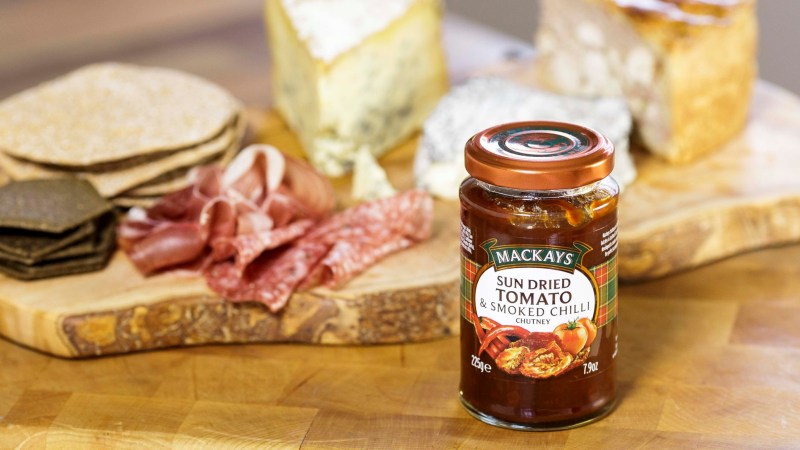Editor’s Note: Last November we had the pleasure of spending 10 captivating days in Scotland. Below is but one adventure of many from our stay. We hope the joy we experienced comes through in all our posts and missives from our adventure, which no doubt read better with a wee dram in hand.
“In 2014 we decided to add our carefully crafted chutney range to our Mackays product family,” explained Martin Grant, Managing Director.
On our whirlwind tour of Scotland, one of our stops was at Mackays Preserves. While a preserves factory may not sound very riveting, it was indeed quite a thrill. Not only did we dress in hair (and beard!) nets along with white lab coats, but we got to see and smell the glorious process of making marmalade, preserves, and curds. Imagine numerous vats of boiling strawberries, peaches and oranges. The fragrance was extreme and delicious.
Halfway through our tour, our wonderful guide, Rochelle, stopped to show us Mackays’ chutney selection. We Americans were rather silent during this presentation, until I finally said, “What the hell is Chutney?”
After everyone gave us a good case of poker face, we had a nearly existential discussion about the product and how it just isn’t something that is popular in America.

But I am getting ahead of myself. Located in Arbroath, part of the Dundee area of Scotland; Mackays has built a reputation for taste, provenance, and tradition. Since 1938, the heart of their product has been the soft fruits grown in the east of Scotland, which they use in every jar of their strawberry, raspberry, and blackcurrant preserve. We love that they work directly with their Scottish fruit farmers who have decades of experience producing the finest soft fruits in the world.
The Dundee area is also the home of marmalade and Mackays is proud to be the custodian of this world-renowned icon (it all started with a Spanish ship in the 18th century. Read more about it here). The secret to their award-winning marmalades is that they source all their bitter oranges from Seville, Spain.

Mackays products are ‘made the authentic way’ and they take pride in cooking their delectable jams and marmalades in traditional open copper pans. They use copper because it’s the best metal for conducting heat and it gives the most even temperature. This slow cooking method allows the flavors of the fruits to be released slowly. Producing quality products in traditional copper pans, Mackays has grown to be sold in over 85 countries. While nearly every British person would be familiar with the brand, it isn’t well known in America, although you can buy the products around the nation (check out where to buy right here).
But back to Chutney. Originating in India, the authentic chutni or chatni of India were usually relishes made from fresh fruits and spices. During the colonial era, the British took this concept home, but this was not the cooked preparation that we are familiar with today. With there being no mangoes, tamarind, or limes in Blighty, British cooks did their best with apples, onions, and vinegar, adding dried fruit such as sultanas, raisins, and dates, to mimic ginger preserves. And so the British welcomed the spiced fruit chutneys to their culinary culture.

“In 2014 we decided to add our carefully crafted chutney range to our Mackays product family,” explained Martin Grant, Managing Director. “There is an ever-growing chutney culture in the UK, and over the years we have taken the opportunity to educate our distributors about the same”.
As we were told by our friends at Mackays, “Here in the UK, we will eat chutney with just about anything – a sandwich isn’t considered a sandwich without a dollop of chutney on the top!” On that note, here are our favourite ways to use Chutney:
- Use a fruit chutney on a cheeseboard or on a chicken sandwich
- Mint & Rosemary Chutney goes well will lamb
- Serve Red Onion Chutney with steak or on BBQ (it’s awesome in meatloaf!)
- Mix in some beetroot chutney into your favorite salad
- Chutney and turkey? Hell yes! Serve some up at Thanksgiving
- And of course it’s awesome with any curry dish


